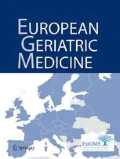Key summary points
To investigate whether a baseline systolic blood pressure (SBP) in older Emergency Department (ED) patients of ≥ 70 years has prognostic value, when compared with the initial SBP at presentation in the ED (= ΔSBP).
AbstractSection FindingsA baseline SBP could be retrieved from the Electronic Health Record for most older ED patients (73.3%). A negative ΔSBP was associated with 30-day mortality. In 20% of the patients with a normal initial SBP in the ED, the ΔSBP was negative, with a high mortality rate.
AbstractSection MessageA baseline SBP value could be retrieved from the Electronic Health Record in most hospitalized ED patients ≥ 70 years. In addition, the 21% with a normal SBP at ED presentation had a negative ΔSBP and these patients had an increased risk for 30-day mortality. As a result, ΔSBP may contribute to improved risk stratification and may help to recognize hypotension in older patients.
Abstract
Purpose
To assess how often baseline systolic blood pressure (SBP) could be retrieved from the Electronic Health Record (EHR) in older Emergency Department (ED) patients. Second, to assess whether the difference between baseline SBP and initial SBP in the ED (ΔSBP) was associated with 30-day mortality.
Methods
A multicenter hypothesis-generating cohort study including patients ≥ 70 years. EHRs were searched for baseline SBPs. The association between ΔSBP and 30-day mortality was investigated.
Results
Baseline SBP was found in 220 out of 300 patients (73.3%; 95%CI 68.1–78.0%). In 72 patients with normal initial SBPs (133–166 mmHg) in the ED, fifteen (20.8%) had a negative ΔSBP with 20.0% mortality. A negative ΔSBP was associated with 30-day mortality (AHR 4.7; 1.7–12.7).
Conclusion
Baseline SBPs are often available in older ED patients. The ΔSBP has prognostic value and could be used as an extra variable to recognize hypotension in older ED patients. Future studies should clarify whether the ΔSBP improves risk stratification in the ED.


Availability of data and material
Data are available upon reasonable request.
References
Lloyd-Sherlock P, Beard J, Minicuci N, Ebrahim S, Chatterji S (2014) Hypertension among older adults in low-and middle-income countries: prevalence, awareness and control. Int J Epidemiol 43(1):116–128
Kaplan MS, Huguet N, Feeny DH, McFarland BH (2010) Self-reported hypertension prevalence and income among older adults in Canada and the United States. Soc Sci Med 70(6):844–849
Kalra D (1994) Medicine in Europe: electronic health records: the European scene. BMJ 309(6965):1358–1361
Chester JG, Rudolph JL (2011) Vital signs in older patients: age-related changes. J Am Med Dir Assoc 12(5):337–343
Pedersen PB, Henriksen DP, Brabrand M, Lassen AT (2020) Level of vital and laboratory values on arrival, and increased risk of 7-day mortality among adult patients in the emergency department: a population-based cohort study. BMJ Open 10(11):e038516
Ljunggren M, Castrén M, Nordberg M, Kurland L (2016) The association between vital signs and mortality in a retrospective cohort study of an unselected emergency department population. Scand J Trauma Resusc Emerg Med 24(1):21
Candel BG, Duijzer R, Gaakeer MI, de Jonge E, de Groot B (2021) The association between vital signs and relevant clinical outcomes in emergency department patients of different age categories. Accepted by the Emergency Medicine Journal
Futier E, Lefrant J-Y, Guinot P-G, Godet T, Lorne E, Cuvillon P et al (2017) Effect of individualized vs standard blood pressure management strategies on postoperative organ dysfunction among high-risk patients undergoing major surgery: a randomized clinical trial. JAMA 318(14):1346–1357
Asfar P, Meziani F, Hamel J-F, Grelon F, Megarbane B, Anguel N et al (2014) High versus low blood-pressure target in patients with septic shock. N Engl J Med 370:1583–1593
Bruijns SR, Guly HR, Bouamra O, Lecky F, Wallis LA (2014) The value of the difference between ED and prehospital vital signs in predicting outcome in trauma. Emerg Med J 31(7):579–582
Kamata K, Abe T, Aoki M, Deshpande G, Saitoh D, Tokuda Y (2020) Dynamic vital signs may predict 30-day mortality in elderly trauma patients. Medicine (Baltimore) 99(25):e20741
Arbabi S, Jurkovich GJ, Wahl WL, Franklin GA, Hemmila MR, Taheri PA et al (2004) A comparison of prehospital and hospital data in trauma patients. J Trauma Acute Care Surg 56(5):1029–1032
Churpek MM, Adhikari R, Edelson DP (2016) The value of vital sign trends for detecting clinical deterioration on the wards. Resuscitation 102:1–5
Brekke IJ, Puntervoll LH, Pedersen PB, Kellett J, Brabrand M (2019) The value of vital sign trends in predicting and monitoring clinical deterioration: A systematic review. PLoS One. 14(1):e0210875
Vest JR, Gamm LD (2010) Health information exchange: persistent challenges and new strategies. J Am Med Inform Assoc 17(3):288–294
Funding
No funding.
Author information
Authors and Affiliations
Contributions
BC and BDG devised and designed the study, contributed to the analyses, and edited the manuscript. IvI and IvD collected and analyzed data, and wrote the manuscript. EDJ, WR and LAAM-E edited the manuscript. BdG takes full responsibility for the study. All authors have read and approved the manuscript.
Corresponding author
Ethics declarations
Conflict of interest
All authors declare no conflicts of interest.
Ethics approval
The medical ethical committee of Máxima MC reviewed the research proposal and concluded that the anonymized data were not subject to the Dutch Research on Humans Subjects Act (in Dutch "WMO") and waived the need for informed consent. The study was approved with registration number (N20.052).
Informed consent
Due to the retrospective design, informed consent was not required.
Additional information
Publisher's Note
Springer Nature remains neutral with regard to jurisdictional claims in published maps and institutional affiliations.
Supplementary Information
Below is the link to the electronic supplementary material.
Rights and permissions
About this article
Cite this article
Candel, B.G.J., van Ingen, I.B., van Doormalen, I.P.H. et al. The difference between the patients' initial and previously measured systolic blood pressure as predictor of mortality in older emergency department patients. Eur Geriatr Med 13, 359–365 (2022). https://doi.org/10.1007/s41999-021-00588-z
Received:
Accepted:
Published:
Issue Date:
DOI: https://doi.org/10.1007/s41999-021-00588-z

